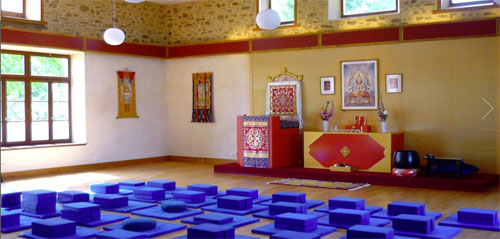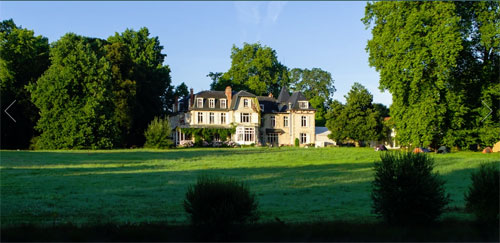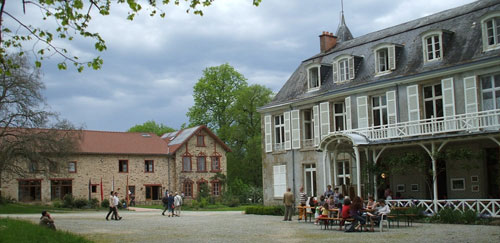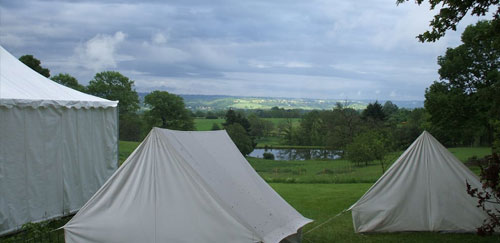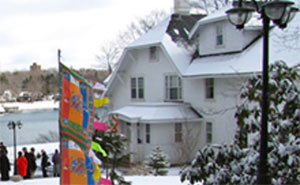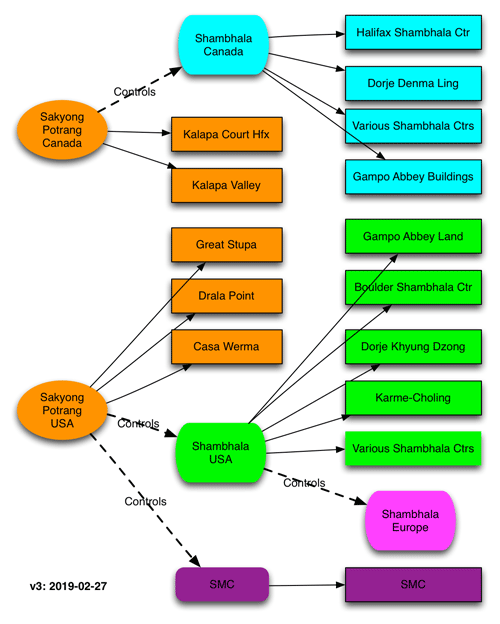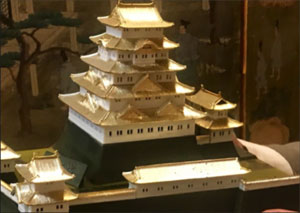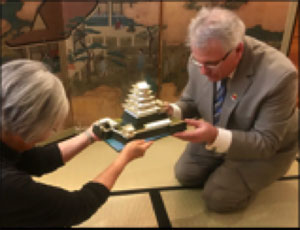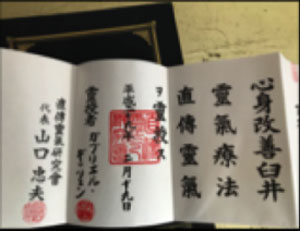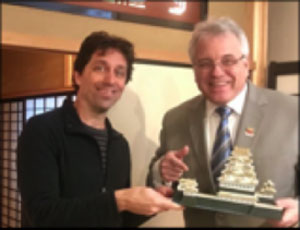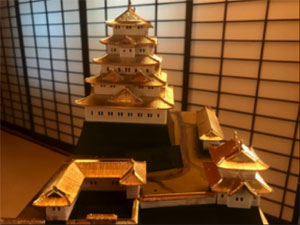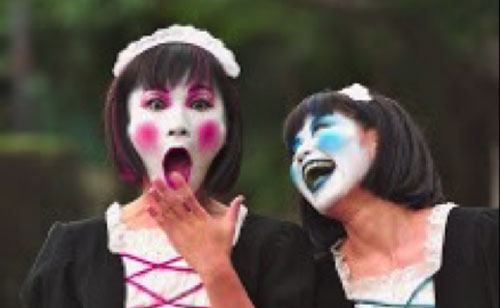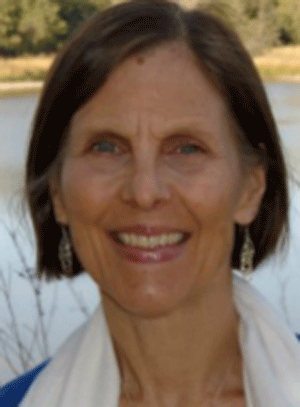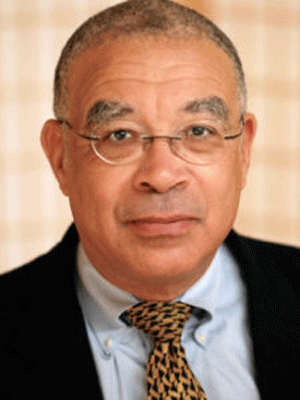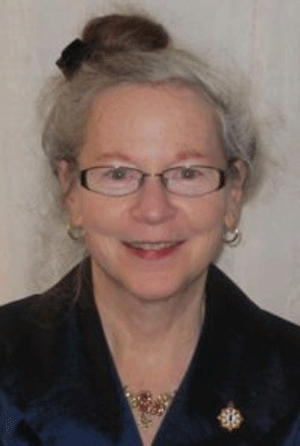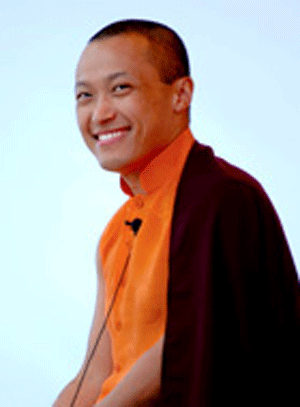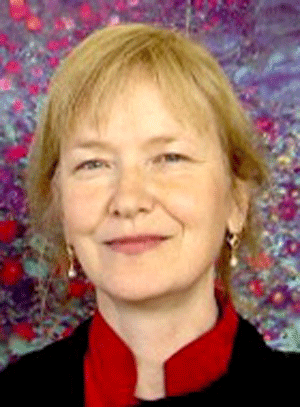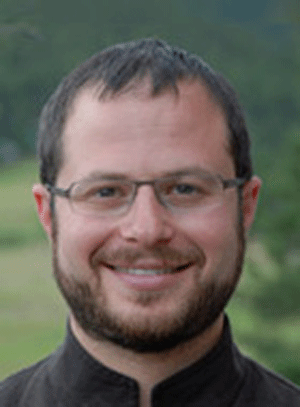Buddha Shakyamuni's Social Consciousness [Excerpt], Chapter 12: Was it Buddhism?, Zen at War, Second Edition
by Brian Daizen Victoria
BUDDHA SHAKYAMUNI'S SOCIAL CONSCIOUSNESS
The basic teachings of Buddha Shakyamuni are well-known, so suffice it to say, there is nothing in either the Four Noble Truths or the Holy Eightfold Path to suggest support for the use of violence, let alone warfare. On the contrary, two admonitions in the Holy Eightfold Path - "right action" and "right livelihood" - clearly indicate the very opposite.
Right action promotes moral, honorable, and peaceful conduct. It admonishes the believer to abstain from destroying life, from stealing, from dishonest dealings, and from illegitimate sexual intercourse. Instead, the believer should help others lead peaceful and honorable lives.
Right livelihood means that one should abstain from making one's living through a profession that brings harm to others, such as selling arms and lethal weapons, providing intoxicating drink or poisons, or soldiering, killing animals, or cheating. Instead, one should live in a way that does not cause harm or do injustice to others.
Together with right speech, right action and right livelihood form the basis for Buddhist ethical conduct. Underlying all Buddhist ethical conduct is a broad conception of universal love and compassion for all living beings, both human and nonhuman. Thus, based on these fundamental teachings of Shakyamuni, Buddhist adherents could in theory no more participate in that form of mass human slaughter known as "war" than they could purposely take the life of another. Yet ideals and practice often parted ways, as we will explore next.
LIFE OF THE BUDDHA
In accordance with the religious norms of his day, Shakyamuni offered advice on secular as well as purely spiritual matters. One example concerns a dispute that arose over the division of water from the drought-stricken Rohini River, which flowed between two kingdoms, one of them his own homeland of Kapilavastu. It is recorded that when the quarrel reached the point where a battle seemed imminent, Shakyamuni proceeded to the proposed battlefield and took his seat on the riverbank. He asked why the princes of the two kingdoms were assembled, and when informed that they were preparing for battle, he asked what the dispute was about. The princes said that they didn't know for sure, and they, in turn, asked the commander- in-chief. He also didn't know and sought information from the regent; and so the enquiry went on until it reached the husbandmen who related the whole affair. "What then is the value of water?" asked Shakyamuni. "It is but little," replied the princes. "And what of princes?" "It cannot be measured," they said. "Then would you," said Shakyamuni, "destroy that which is of the highest value for the sake of that which is worth little?" Reflecting on the wisdom of his words, the princes agreed to return peaceably to their homes.1
Another example of Shakyamuni's political intervention is said to have occurred in his seventy-ninth year, shortly before his death. King Ajatasattu of Magadha wished to make war on the tribal confederation of Vajji, so he sent an emissary to ask Shakyamuni what his chances of victory were. Shakyamuni declared that he himself had taught the Vajjians the conditions of true welfare, and as he was informed that the Vajjians were continuing to observe these conditions, he foretold that they would not be defeated. Upon hearing this, Ajatasattu abandoned his plan to attack.
Significantly, the first of the seven conditions Shakyamuni had taught the Vajjians was that they must "hold frequent public assemblies:' Secondly, they must "meet in concord, rise in concord, and act as they are supposed to do in concord."2 As a noted scholar pointed out, these conditions represent "a truly democratic approach," and "any society following these rules is likely to prosper and remain peaceful."3
A. L. Basham suggests that incidents like these demonstrate Shakyamuni's clear support for a republican form of government, though with the caveat that we are speaking of a form of governance in which there was an executive- sometimes elected, sometimes hereditary-supported by an assembly of heads of families that gathered periodically to make decisions relating to the common welfare.4 Restated in more contemporary terminology, Shakyamuni advocated a political model approaching a small-scale, direct -democracy,-though it is also clear that he did not-deny his counsel to the kings of the rising monarchies of his day.
Other elements of Shakyamuni's stance on violence are illustrated in the lead-up to an attack on his homeland by King Vidudabha of Kosala, the most powerful of the sixteen major kingdoms of his time. Shakyamuni recognized that this time the nature of the feud was such that his words would not be heeded, and he did not attempt to intervene. But even when the very existence of his homeland was at stake, Shakyamuni, his warrior background notwithstanding, refused to take up arms in its defense.
Shakyamuni's teaching on warfare and violence is perhaps best clarified in the Dhammapada, a Pali canonical work. In chapter 1, stanza 1, for example, Shakyamuni states: "For never does hatred cease by hatred here below: hatred ceases by love; this is an eternal law." And again, in chapter 15, stanza 201: "Victory breeds hatred, for the conquered is unhappy. The person who has given up both victory and defeat, that person, contented, is happy." In chapter 10, stanza 129, he says: ''All persons tremble at being harmed, all persons fear death; remembering that you are like unto them, neither strike nor slay." And finally, in chapter 8, stanza 103: "If someone conquers in battle a thousand times a thousand enemies, and if another conquers himself, that person is the greatest of conquerors."5 While scholars doubt these admonitions came directly from Shakyamuni's lips, the admonitions are, nevertheless, entirely consistent with his earliest and most fundamental teachings.
Two further aspects of Shakyamuni's teachings are worthy of mention. First, he was concerned about what we would today call social justice. For example, in the Pali Cakkavattisihanada Sutta of the Digha Nikaya (no. 26), Shakyamuni clearly identified poverty as the cause of violence and other social ills:As a result of goods not being accrued to those who are destitute, poverty becomes rife. From poverty becoming rife, stealing, ... violence, ... murder, ... lying, ... evil speech, ... adultery, ... incest, till finally lack of respect for parents, filial love, religious piety and lack of regard for the ruler will result.
Likewise, in the Kutadanta Sutta of the same Nikaya (no. 5), Shakyamuni praised a king named Mahavijita who, faced with an upsurge of robbery in his impoverished kingdom, provided his subjects with the economic means to improve their lives rather than imprisoning and executing the wrongdoers.6
THE EARLY BUDDHIST SANGHA AND THE STATE
Also important is the political or social dimension of the religious organization that Buddha Shakyamuni founded, the Sangha, that is, the community of monks and nuns (organized separately) dedicated to practicing his teachings. Primarily religious in nature, it embodied his concept of an ideal society.
The Sangha was based on noncoercive, nonauthoritarian principles by which leadership was acquired through superior moral character and spiritual insight, and monastic affairs were managed by a general meeting of the monks (or nuns). Unlike a modern business meeting, however, all decisions required the unanimous consent of those assembled. When differences could not be settled, a committee of elders was charged with finding satisfactory solutions.
Ideally, the Sangha was to be an organization that had no political ambitions and in whose ranks there was no striving for leadership. It sought by example and exhortation to persuade men and women to follow its way, not by force. Further, by his completely eliminating the then-prevalent caste system from its ranks, Shakyamuni may rightly be considered one of recorded history's first leaders to practice his belief in the basic equality of all human beings. He clearly hoped that the religious and social ideals of the Sangha would one day permeate the whole of society. This said, the historical subordination of the female Sangha to the male Sangha, through the imposition of eight additional precepts for nuns, betrays the ideal of human equality and points to the existence of a sexist attitude that may date back to Shakyamuni himself.
It is also true that even during the Buddha's lifetime, his Sangha became a wealthy landowner, though the lands referred to were held as the communal property of the various monastic communities.7 The lands themselves had all been donated by the faithful, initially kings, princes, and rich merchants. This raises the question as to what the donors expected of the Sangha in return for their material support. The classic answer is that they expected to acquire "merit," that spiritual reward that promises rebirth in a blessed state to all those who perform good deeds. As one Pali sutra relates, however, the accumulation of merit by the laity can also lead to the more immediate and mundane goals of "long life, fame, heavenly fortune, and sovereign power [italics mine]."8 The fact that King Ajatasattu also looked to Buddha Shakyamuni to forecast the likelihood of his victory against the Vajjians is significant here. Significant, in that it was already widely believed in ancient India that accomplished "holy men" possessed superhuman powers, including the ability to foresee the future.
Related questions are what effect the Sangha's collective possession of ever-greater amounts of land had on its own conduct, and equally important, whether as a major landholder it could fail in its actions and pronouncements to escape the notice and concern of state rulers. Would it be surprising to learn that these rulers also expected something in return for their material support of the Sangha, something approaching a moral endorsement of their rule, or the acquisition of merit, or the utilization of the supposed superhuman powers of Buddhist priests (and sutras) to protect the state from its enemies or ensure victory in battle?
KING ASHOKA-THE "IDEAL" BUDDHIST RULER?
If in the long run the Sangha willingly provided rulers with a moral endorsement, that endorsement was initially given only on the basis that rulers fulfill certain prerequisites or conditions. These conditions were contained in the Jataka stories, five hundred Indian folk tales that had been given a Buddhist didactic purpose and were incorporated into the Pali Buddhist canon sometime before the beginning of the Christian era. Among these tales we find a description of the "Ten Duties of the King," which include, among other things, the requirement that rulers abstain from anything that involves violence and destruction of life. Rulers are further exhorted to be free from selfishness, hatred, and falsehood, and to be ready to give up all personal comfort, reputation, fame, and even their very life if need be to promote the welfare of the people. Furthermore, it was the responsibility of kings to provide (1) grain and other facilities for agriculture to farmers and cultivators, (2) capital for traders and those engaged in business, and (3) adequate wages for those who were employed. When people are provided with sufficient income, they will be contented and have no fear or anxiety. Consequently, their countries will be peaceful and free from crime.9
It was, of course, one thing to present kingly duties in the abstract and another to find kings who actually practiced them. Buddhists discovered one such ruler in the person of King Ashoka (ca. 269-32 B.C.E.), who already controlled much of India at the time of his accession to the throne. Prior to converting to Buddhism, Ashoka is said to have engaged in wars of expansion until the bloodiness of his conquest of the kingdom of Kalinga caused him to repent and become a Buddhist layman, forswearing the use of violence. He then embarked upon a "Reign of Dharma" in which he advocated such moral precepts as nonharming, respect for all religious teachers, and noncovetousness.
In addition to renouncing aggressive warfare, Ashoka is said to have urged moderation in spending and accumulation of wealth, kind treatment of servants and slaves, cessation of animal sacrifices for religious purposes, and various other maxims, all carved as inscriptions and royal edicts on cliff faces and stone pillars throughout his vast realm, which extended almost the entire length and breadth of the Indian subcontinent. Further, he appointed officers known as Superintendents of Dharma for the propagation of religion, and arranged for regular preaching tours. Realizing the effectiveness of exhortation over legislation, he is said to have preached the Dharma on occasion. Ashoka become the archetypal Buddhist ruler, an ideal or Universal Monarch (see chapter 7).
As opposed to this idealized portrait, Indian historian A. L. Basham has pointed to another side of King Ashoka. For example, Ashoka maintained an army and used force against tribal groups that clashed with his empire. Beyond that, one Buddhist description of his life, the Sanskrit Ashokavandana, records that he ordered eighteen thousand non-Buddhist adherents, probably Jains, executed because of a minor insult to Buddhism on the part of single one. On another occasion, he forced a Jain follower and his entire family into their house before having it burnt to the ground. He also maintained the death penalty for criminals, including his own wife, Tisyaraksit whom he executed. In light of these and similar acts, we can say that Ashoka was an archetypal "defender of the faith" who was not averse to the use of violence.
Nor did King Ashoka's remorse at having killed over 100,000 inhabitants of Kalinga lead him to restore its freedom or that of any other of his earlier conquests. Instead, he continued to govern them all as an integral part of hi empire, for "he by no means gave up his imperial ambitions."10 In fact, inasmuch as many of his edicts mention only support for Dharma, (a pan-Indian politico-religious term) and not the Buddha Dharma, it is possible to argue that he used Dharma not so much out of allegiance to the Buddhist faith and its ideals, but as a means to centralize power, maintain unity among his disparate peoples, and promote law and order throughout the empire.
At the very least, in promoting Buddhism throughout India, Ashoka Was clearly also promoting his own kingship and establishing himself.11 That is to say, an alliance of politics and religion had been born. This is important to note because while Ashoka may have been the first to use Buddhism and the (Buddha) Dharma for what we would today identify as political purposes, he was hardly the last, as we shall see shortly when we examine the development of Buddhism in China and Japan.
A noted Indian political philosopher, Vishwanath Prasad Varma, pointed out that due to King Ashoka's royal patronage, "the Sangha became contaminated with regal and aristocratic affiliations."12 Similarly, the pioneer Buddhist scholar T. W. Rhys Davids remarked that it was the Sangha's close affiliation with King Ashoka that was "the first step on the downward path of Buddhism, the first step on its expulsion from India."13
What is certain is that Ashoka enjoyed a great deal of power over the Sangha. For example, a second Buddhist record of Ashoka's life, the Pali Mahavamsa, states that Ashoka was, with the aid of the great elder Moggaliputta Tissa, responsible for defrocking sixty thousand Sangha members who were found to harbor "false views."14 Ashoka had the power to prescribe passages from the sutras that Sangha members were required to study. Those who failed to do so could be defrocked by his officers.15 In fact, it became necessary to receive Ashoka's permission even to enter the priesthood.16 In short, during Ashoka's reign, if not before, the Raja Dharma (Law of the Sovereign) became deeply involved in, if not yet in full command of, the Buddha Dharma. This too was a harbinger of things to come.
In this connection, both Basham and Rhys Davids identified the concept of a so-called Universal Monarch, or Cakravartin (Wheel-Turning King), as coming into prominence within Buddhist circles only after the reign of Ashoka's father, Candragupta, who ascended the throne sometime at the end of the fourth century B.C.E,17 Thus, the idea of a Universal Monarch, who served as the protector of the Buddha Dharma and as the recipient of the Dharma's protection, did not originate as a teaching of Buddha Shakyamuni himself. Instead, it is best understood as a later accretion that "'was an inspiration to ambitious monarchs, ... some [of whom] claimed to be Universal Monarchs themselves."18 It is also significant that as a Universal Monarch and Dharma Protector, Ashoka was accorded the personal title of Dharma Raja (Dharma King), a title he shared with Buddha Shakyamuni,19 This "sharing of titles" would play an important role in China.
BUDDHISM IN CHINESE SOCIETY
Confucian Critique of Early Buddhism in China
Buddhism entered China by way of Central Asia at the beginning of the Christian era. By this time China already had a sophisticated culture of its own that included two well-developed, indigenous, religious-oriented belief systems: Taoism and Confucianism. Buddhist advocates eventually reached an uneasy truce with both Taoists and Confucians, who initially opposed the introduction of this foreign religion.
Chinese Buddhist monks appeased the Taoists by discussing Buddhism in a Taoist vocabulary and proposing Buddhist solutions to unresolved Taoist doctrinal disputes, such as the relationship of the "holy man" to the world. However, it was the compromise reached with the Confucians that was to have the most far-reaching effects on the subsequent development of Buddhism throughout East Asia, including Japan.
The compromise concerned the relationship of the Sangha with the state. As propagators of a universal Dharma, Chinese monks of the Eastern Chin dynasty (317-420 C.E.) asserted they had no need to kowtow (show obeisance) to the emperor. From the popular Confucian viewpoint, this was a heretical doctrine that undermined Confucian advocacy of social harmony derived from a strictly hierarchical conception of society, in which nothing was higher than the "Son of Heaven."
Subordination of Buddhism to the State
While Buddhist monks in southern China (under the Chin dynasty) successfully maintained independence from the state, their northern counterparts did not fare as well. Faced with the non-Chinese rulers of the Northern Wei dynasty (386-534 C.E.), Buddhist monks offered their services as political, diplomatic, and military advisers. They claimed to be able to prophesy not only the outcome of battles and entire military campaigns, but even the rise and fall of empires. According to Kenneth Chen, in offering their technical services to the rulers, these imperial monk advisors were able to persuade them to become staunch supporters of Buddhism."20
In justifying the decision of northern monks to reverence the emperor in accordance with Confucian tradition, Fa-kuo, chief of monks from 396 to 398, came up with an "ingenious solution." Namely, he claimed that then Emperor T'ai-tsu was a living Buddha, the Tathagata himself. Therefore, when a monk bowed down to him, he was not doing obeisance to an emperor but was worshipping the Buddha, an entirely fit and proper act for all faithful.21 Fa-kuo, it should be noted, had been appointed to his position by Emperor T'ai-tsu. Although the effect this had on Fa-kuo's views is unknown, it is significant that a Chinese emperor possessed the authority to make such an appointment over the Sangha. This said, it must also be remembered that Fa-kuo's innovation was based on such Indian precedents as the "sharing of titles" in the Buddhist records of King Ashoka's reign. Furthermore, there was, by this time, scriptural justification for Fa-kuo's position in the Suvarnaprabhasa [Golden Light] Sutra. This Indian Mahayana sutra took the view that while a king is not a god in his own right, he does hold his position by the authority of the gods and is therefore entitled .o be called a "son of the gods." It can readily be seen that this position, which is Brahmanical (not Buddhist) in origin, dovetails nicely with the Chinese doctrine of a ruler's Mandate of Heaven. Further paralleling the Chinese doctrine, there is an implicit admission in this sutra (and in its Chinese variant) that revolt against a wicked or negligent king is morally acceptable.
Whatever motives one may ascribe to these northern Buddhist monks, the fact remains they established a pattern that was to characterize Chinese Buddhism down through the ages. That is to say, in return for imperial patronage and protection, Buddhism was expected to serve and protect the interests of the state and its rulers, including the attainment of victory on the battlefield. Thus was the foundation laid for what came to be known in Japan as "Nation Protecting-Buddhism:' It can be argued, of course, that this was but an extension of the Sangha's subservience to the state as first observed in India.
Be that as it may, when a subsequent emperor-Wen (r. 581-604) of the Sui dynasty (c. 581-618)-decided to enlist the spiritual aid of Buddhist monks in his military campaigns, he was doing no more than extending a precedent that had already existed for more than two hundred years, at least in northern China. Specifically, Wen constructed temples at sites where he and his father had won important battles, ordering temple priests to hold commemorative services for the spirits of his fallen soldiers. Already in the midst of planning future military campaigns, the emperor wanted to assure his followers that should they fall on some future battlefield, their spirits, too, would be looked after.22
Emperor Wen's innovation was his determination to use Buddhism as a method of unifying all of China. Presenting himself as a Universal Monarch, soon after establishing the Sui dynasty in 581 C.E. he declared:With the armed might of a Cakravartin King, We spread the ideals of the ultimately benevolent one [that is, the Buddha]. With a hundred victories and a hundred battles, We promote the practice of the ten Buddhist virtues. Therefore We regard weapons of war as having become like incense and flowers [presented as offerings to the Buddha] and the fields of this visible world as becoming forever identical with the Buddha land [italics mine].23
To secure his position still further, Wen gave himself the title Bodhisattva Son of Heaven, and proceeded to have hundreds of stupas built throughout China to enshrine Buddhist relics. This conveyed the unity of king and empire through faith in Buddhism. In doing this, he was once again emulating pious acts by that other great empire builder, King Ashoka. Ashoka allegedly had eighty-four thousand stupas constructed throughout his empire.24
However, for the imperial support it enjoyed, the Sangha always paid a heavy price in the loss of its independence, even in internal affairs, and in increasing subservience to the state. Thus, after Emperor Yang succeeded to the throne in 604 (by killing his father, Emperor Wen), he issued a decree in 607 ending the exemption of monks in southern China from having to pay homage to the emperor and his officials. The Law of the Sovereign was now supreme in China and would remain so, as far as Buddhism was concerned, forevermore. One added "benefit" of this subservience was, however, that Buddhism gained at least a degree of acceptance by the Confucians.
The Sangha's support of state interests did not stop with prophesy, state ritual, and provision of a unifying ideology. By the time of the T'ang dynasty (c. 618-907), some monks had themselves begun to participate directly in politics. During the reign of Wu Tse-t'ien, for example, one monk by the name of Hsueh Huai-i was actually commissioned as a "grand general sustaining the state:' As such, he led a number of military expeditions to expel Turks who had invaded China's border regions. Later, Huai-i even attempted to usurp the throne for himself.25
Monks meddling in politics (and warfare) suggests, of course, that decadence had infiltrated the Sangha under imperial patronage. In fact, one official of the time complained that "present-day temples surpass even imperial palaces in design, embodying the last word in extravagance, splendor, artistry, and finesse."26 Thus, when Emperor Hsuan-tsung ascended the throne in 712, he instituted a series of measures to control the Sangha's wealth and power, including limitations on the size of temple landholdings, defrocking of up to thirty thousand "unworthy monks:' and requiring government permission before repairs to temples could be made. In order to control the number of entrants into the Sangha, the emperor also initiated a system of granting official "monk certificates" in 747.27
None of these acts, however, can begin to-compare to the suppression of Buddhism that occurred at the hands of Emperor Wu-tsung in 845. At the time, the emperor claimed to have forced 260,500 monks and nuns to return to lay life, while destroying 44,600 monasteries, temples, and shrines, and confiscating their vast, tax-exempt lands and 150,000 slaves.28 Although the emperor's death the following year marked the formal end of the persecution, Buddhism never regained its preeminent position in Chinese life and society. A long period of decline set in, extending to the present day. Only the Ch'an (Zen) and Pure Land schools maintained a certain degree of vitality.
Ch'an
Ch'an's resilience may have derived in part from its syncretism, for Ch'an had incorporated both Taoist and Confucian tenets into its practice and outlook. By the Sung period (960-1279) if not before, it was typical for Ch'an masters (like other Chinese Buddhists) to refer to Buddhism as one leg of a religious tripod that also included Confucianism and Taoism. Japanese Zen Master Dogen, who trained in China from 1223 to 1227, described this syncretism:Among present-day monks ... not one of them, not even half of one of them, has understood that the Buddha's teachings are superior to those of the other two. It was only Ju-ching, my late master, who understood this fact and proclaimed it ceaselessly day and night.29
Ju-ching, it should be noted, also refused both an honorary purple robe and the title "Ch'an Master" from Emperor Ning-tsung. Further, in the context of explaining the differences between Buddhism and Confucianism, Dogen characterized Confucianism as "merely teach[ing] loyal service to the emperor and filial piety, the latter seen as a method of regulating one's household [italics mine]"30
This syncretism on the part of nearly all Ch'an masters meant that Ch'an, like the rest of Chinese Buddhism, internalized Confucian values, including emphasis on a hierarchical social structure with the emperor at the pinnacle of the social pyramid. Confucians argued that such a configuration would produce social harmony when everyone knew their place in society and faithfully followed the dictates of their superiors.
Iconoclasm
Although based more on rhetoric than actual historical practice, Ch'an has a reputation for iconoclasm, dismissing, as it does, the need for scholastic study of Buddhist texts and dependence on Buddhist images and rituals. Coupled with Ch' an's emphasis on productive labor, this led, at least initially, to a certain degree of independence from, if not indifference to, the emperor and the imperial state. For example, consider Hui-neng, traditionally seen as the pivotal Sixth Patriarch of the Southern school of Ch'an. Although there are conflicting accounts of his life, the Special Transmission of the Great Master from Ts'ao-ch'i presents this master as being so unconcerned with worldly fame that he refused an invitation from the emperor to visit the imperial court. Notwithstanding this, the emperor still presented him with gifts, one of which was, significantly, a new name for his former residence, that is, Kuo-en-ssu (Temple to Repay the Debt of Gratitude Owed the State).
Hui-neng's disciple Shen-hui (684-758), however, maintained a much closer, if sometimes strained, relationship with the imperial court. Heinrich Dumoulin noted that Shen-hui first took up residence in Nan-yang, not far south of the imperial capital of Lo-yang, in 720 in obedience to an imperial decree. In 745, Shen-hui moved to a temple in Lo-yang, where large crowds were drawn to hear his exposition of Ch'an teachings. This led to charges, perhaps incited by his Northern Ch'an rivals, that he was fomenting social unrest, resulting in his banishment from the capital for three years (753-56).
In 755 when a major rebellion broke out in the northeastern part of the country, Shen-hui was recalled to the capital as a fundraiser for the imperial military. Offering his contributors exemption from both monetary taxation and the requirement to participate in yearly, government-sponsored labor battalions, Shen-hui proved an exemplary fundraiser, and the rebellion was suppressed. The emperor gratefully showered Shen-hui with honors, ensuring that his last days were spent "basking in the graces of the powers that be."31
In light of this and similar episodes, it is clear that Ch'an leaders also willingly served the state's needs, in war as well as peace. In fact, when the Soto and Rinzai sects raised funds to buy fighter aircraft for the Japanese military in the 1930s and 1940s, they were following a Ch'an and Zen precedent with a history of nearly 1,200 years! As for Shen-hui, he continued to be honored even after his death, and in 796 was formally recognized as the Seventh Patriarch, also by virtue of an imperial decree.32 Inasmuch as Shen-hui had been an untiring advocate of the Southern Ch'an school and its doctrine of sudden enlightenment, this imperial recognition was destined to have a major impact on subsequent Ch'an history.
Shen-hui was but one figure in the long-term decline of the Buddhist tradition of nonviolence. Consider the following poem in a sixth-century treatise from the Hsin-hsin Ming by the Third Ch'an Patriarch, Seng-ts'an (d. 606):Be not concerned with right and wrong
The conflict between right and wrong
Is the sickness of the mind)3
Further, French scholar Paul Demieville pointed out that according to the seventh-century Ch' an text "Treatise on Absolute Contemplation," killing is evil only in the event the killer fails to recognize his victim as empty and dream-like. On the contrary, if one no longer sees his opponent as a "living being" separate from emptiness, then he is free to kill him.34 This antinomian license to kill with moral impunity is the most dangerous, and deadly, of Ch'an's many "insights."
This said, Ch'an's abandonment of Buddhist morality did not go unnoticed or unchallenged. As early as the eighth century, the famous writer Liang Su (753-93) criticized the Ch'an school as follows:Nowadays, few men have true faith. Those who travel the path of Ch'an go so far as to teach the people that there is neither Buddha nor Dharma, and that neither good nor evil has any significance ... Such ideas are accepted as great truths that sound so pleasing to the ear. And the people are attracted to them just as moths in the night are drawn to their burning death by the candle light [italics mine].35
In reading this critique, one is tempted to believe that Liang was also a prophet able to foresee the deaths over a thousand years later of millions of young Japanese men who were drawn to their own deaths by the Zen-inspired "light" of Bushido. All the more, the millions of innocent men, women, and children who burned with (or because of) them, and who must never be forgotten.
By the Sung dynasty (960-1279), Ch'an monasteries not only maintained friendly relations with the imperial court but had become involved in political affairs as well.36 Emperors granted noted Ch'an masters purple robes and honorific titles such as "Ch'an Master of the Buddha Fruit" or "Ch'an Master of Full Enlightenment." Inevitably, however, imperial favors brought with them increased state control. One result was the establishment of the system of "Five Mountains [i.e., major monasteries] and Ten Temples." In the spirit of Confucian hierarchy, Ch'an temples were classified and ranked, those at the top being blessed with imperial favors. In this case, all of the privileged temples belonged to the Yang-ch'i line of the Linchi (J. Rinzai) school.
Among other things, Ch'an temples operating under imperial patronage were expected to pray for the emperor and the prosperity of the state. In describing this system, Yanagida Seizan wrote:Given the danger of foreign invasion from the north, Buddhism was used to promote the idea of the state and its people among the general populace .... Inevitably, the Ch'an priests residing in these government temples in accordance with imperial decree gradually linked the content of their teaching to the goals of the state. This is not unconnected to the fact that Zen temples [in Japan] in the Kamakura and Tokugawa periods had ... a nationalistic character in line with the traditional consciousness of the Chinese Ch'an school that advocated the spread of Ch' an in order to protect the nation.37
The succeeding Yuan period (c. 1280-1368) would bring even greater state control of Ch' an and other temples and monasteries. Gradually however, the syncretic tendencies already at work within Buddhism grew ever stronger until by the Ming period (c. 1368-1644) all Chinese Buddhist schools and sects fused into a loose amalgamation of the Ch'an and Pure Land schools. This brought the story of a distinct Ch'an school or movement to an end.
Preliminary Conclusion
In light of this discussion, I would like to make three additional points. First, while Ch'an's iconoclastic tendencies and economic self-reliance may have initially enabled it to maintain a certain distance from the state, over the long term there was a spiritual price for this freedom. That is to say, paralleling a heavy emphasis on the practice of meditation (J. zazen), intellectual stimulation from such activities as lively discussions on points of doctrine were strongly discouraged by Ch'an masters, who insisted on intuitive comprehension and lightning-quick responses within an overall framework of anti-textualism and anti-scholasticism. To some extent, this can be seen as Ch' an's internalization of such Taoist values as spontaneity, originality, paradoxy, innate naturalness, and the ineffability of Truth.38
I am not suggesting that the strong emphasis on meditation or Taoist-influenced values was necessarily "un-Buddhist," but as Kenneth Ch'en pointed out:The strength and vigor of Buddhism rested on the principle of equal emphasis on all three aspects of the Buddhist discipline -- moral conduct, [meditative] concentration, and wisdom. Special attention to one, to the neglect of the other two, would certainly result in the deterioration of the Dharma.39
The reader will recall that Hakamaya Noriaki also raised a related criticism of Japanese Zen when he said, "True Buddhists must draw a sharp distinction between Buddhist teachings and anti-Buddhist teachings, using both intellect and language to denounce the latter [italics mine]."
My second point is closely connected with the first. I refer to what might be called a "violence-condoning atmosphere" fostered as one dimension of Ch'an's iconoclastic attitude. Historically, this atmosphere began as early as the second patriarch, Hui-k'o (c. 484-590), who, tradition states, cut off his left arm at the elbow to show how fervently he wished to become a disciple of Bodhidharma, the legendary fifth-century Indian founder of the Ch'an school in China. T'ang Ch'an Master Chu-chih is also recorded as having cut off his disciple's finger with a knife after discovering that the latter had been imitating his "one finger Ch'an" (though in doing so, Chu-chih allegedly precipitated the disciple's enlightenment).
Less dramatic, though far more widespread, was the Ch'an use of such training methods as physical blows from both fists and staffs, together with thundering shouts. Lin-chi I-hsuan (d. 866), founder of the Lin-chi school, is the preeminent example of such a "rough and tumble" master. It was this master who taught his disciples:Followers of the Way, if you wish to have a viewpoint that is in accord with the Dharma, it is only [necessary] that you not be beguiled by others. Whether you meet them within or without, kill them right away! When you meet the Buddha, kill him. When you meet a patriarch, kill him. When you meet an Arhat [enlightened person], kill him. When you meet parents, kill them. When you meet relatives, kill them. Thus you will begin to attain liberation. You will be unattached and be able to pass in and out [of any place] and become free.40
I do not suggest there is a direct link between Ch'an's physical and verbal violence and the later emergence of Zen's support for Japanese militarism. All of the examples given above have legitimate didactic purposes within the Ch'an and Zen tradition. For example, in Lin-chi's oft-misunderstood admonition quoted above, the "killing" referred to is that of detaching oneself from dependency on authority figures, whether they be people or ideas, in order to achieve genuine spiritual liberation. It might be called a dramatic restatement of Buddha Shakyamuni's own final instructions to his disciples:You must be lamps unto yourselves. You must rely on yourselves and on no one else. You must make the Dharma your light and your support and rely on nothing else.41
Lin-chi's statement, like that of Shakyamuni, is basically anti-authoritarian in that it aims to free the trainee from dependence on anyone or anything outside of his own mind and apart from his own direct experience of the Dharma. Nevertheless, Ch'an's verbal and physical violence, didactic though it be, lent itself to misuse and abuse by later practitioners, especially in Japan. It provided the link that facilitated the connection made between Zen and the sword in feudal Japan, and in turn, between Zen and total war in modern Japan. Note too, that it was Ch'an Master Kuei-shan Ling-yu (771-853) who first referred to the interplay between action and silence in Ch'an as "sword-play."42 Lin-chi was also fond of referring to "swords" and "sword-blades:' but the reference was to the "sword of wisdom:' a common Buddhist metaphor referring to wisdom that can "cut through" (i.e., eliminate) all discriminating thought and conceptualization, not human flesh!
D. T. Suzuki's application of the Zen phrase "the sword that gives life" (J. katsujin-ken) to the modern battlefield is a particularly pernicious example of the abuse of Zen terminology. This phrase together with its twin, that is, "the sword that kills" (J. satsujin-to), is found in the famous Sung dynasty collection of one hundred Zen koans known as the Blue Cliff Record. In introducing the twelfth koan of the collection, Ch'an master Yuan Wu K'e Ch'in (1063-1135) wrote:The sword that kills people and the sword that gives life to people is an ancient custom that is also important for today. If you talk of killing, not a single hair is harmed. If you talk of giving life, body and life are lost [italics mine].43
Although phrased paradoxically, it is obvious that the above does not refer to anyone's physical death. Rather, Yuan Wu, once again using the sword as a metaphor for Buddhist wisdom, dramatically restates the classical Zen (and Buddhist) position that the destruction (i.e., the "killing") of the illusory self does not result in the least injury to the true self (hence, "not a single hair is harmed"). Or, expressed in reverse order, "giving life" to the true self inevitably involves the destruction of the illusory self (hence, "body and life are lost"). Thus, whichever sword is spoken of, no one physically dies!
One can only marvel at the fact that the transference of these terms to the real battlefield by later generations, Suzuki and his ilk included, has for so long escaped criticism and condemnation. At least part of the responsibility for this must be laid at the feet of those Ch'an pioneers, like Lin-chi, who chose to incorporate "life-giving" blows and shouts, coupled with a vocabulary of violence, into their instructional regimen. In the hands of lesser men (especially those aided and abetted by the state) these methods became, as has been seen, lethal in the extreme.
Finally, I would point out that the subordination of the Buddha Dharma to the state continues to exert a significant impact on Chinese Buddhism to this very day. In his book Buddhism under Mao, Holmes Welch noted that in 1951-52, Chinese Buddhists raised money for a fighter aircraft named Chinese Buddhist to be used against UN (mainly American) forces in the Korean War. In justifying Buddhist support for the Chinese government's policy of military intervention, a Buddhist leader named Hsin-tao addressed a meeting of Nan-ch'ang Buddhists as follows:We know that the People's Government absolutely guarantees the freedom of religious belief. We Buddhists must unite as quickly as possible and, with the followers of other religions, completely support the Chinese Volunteer Army and the Korean People's Army. The best thing is to be able to join the army directly and to learn the spirit in which Shakyamuni, as the embodiment of compassion and our guide to Buddhahood, killed robbers to save the people and suffered hardship on behalf of all living creatures. To wipe out the American imperialist demons who are breaking world peace is, according to Buddhist doctrine, not only blameless but actually gives rise to merit [italics mine].44
Once again, America and its allies were fighting "Buddhism:' if not necessarily at sea, then at least on the ground and in the air. Once again, Buddhists themselves took up arms, out of a spirit of compassion, to fight the American "demons:' As in wartime Japan, scriptural justification was also used in the Buddhist campaign to raise funds for weapons. Chu-tsan, another Buddhist leader wrote,The [Mahaparilnirvana Sutra advocates wielding the spear and starting battle. Therefore there is nothing contrary to Buddhist doctrine in a Buddhist responding to the appeal to contribute towards fighter planes, bombers, cannons and tanks.45
Ironically, when Tibetan monks revolted against the Communist Chinese Army's occupation of Tibet in 1959, they used the same scriptural evidence to justify their armed resistance.
The Chinese government's political use of Buddhism is by no means at an end, most especially in relation to Tibet. As recently as May 1996, the Chinese government donated a large memorial plaque to a Tibetan temple that read "Protect the State; Benefit the People."46 In doing this, the state (albeit communist) sought to portray itself once again as a patron of Buddhism, but on the same condition as always, that is to say, that Buddhism agree to protect the state. In this instance there was an added "Tibetan twist" to the state's munificence, for clearly Tibetan Buddhists were also expected to protect the unity of the state from those alleged "splittists" (like the Dalai Lama and his supporters) who continued to seek some form of Tibetan autonomy.
In Taiwan, on the other hand, the Nationalist Chinese government has supported Buddhism far more strongly, receiving in return Buddhist leaders' endorsement of that government's longstanding dream to militarily retake the mainland. In light of this, it is not surprising to learn that Taiwanese monks share the same attitude toward Buddhist-endorsed violence as their mainland brethren. One such monk, a disciple of the modern Buddhist reformer T'ai-hsu (1890-1947), said,According to the Mahayana it is guiltless to kill from compassion. If I kill you, the objective is not to kill you, but to save you, because if I do not kill you, you will kill a great many other people, thus causing great suffering and incurring great guilt. By killing you, I prevent you from doing this, so that I can save both you and them. To kill people from compassion in such a way is not wrongdoing.47
There was, of course, one difference between the refugee monks on Taiwan and in Hong Kong and those on the mainland: the former wished Buddhist-condoned violence to be used against the Communists, instead of on their behalf. As always, the one constant is that the Law of the Sovereign, or in other words, the state and its rulers, is supreme!
Cont'd below

